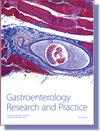The Comparison of Diagnostic Ability between Blue Laser/Light Imaging and Narrowband Imaging for Sessile Serrated Lesions with or without Dysplasia
IF 2
4区 医学
Q3 GASTROENTEROLOGY & HEPATOLOGY
引用次数: 0
Abstract
Objectives. Diagnostic ability of sessile serrated lesions (SSL) and SSL with dysplasia (SSLD) using blue laser/light imaging (BLI) has not been well examined. We analyzed the diagnostic accuracy of BLI for SSL and SSLD using several endoscopic findings compared to those of narrow band imaging (NBI). Materials and Methods. This was a subgroup analysis of prospective studies. 476 suspiciously serrated lesions of ≥2 mm on the proximal colon showing serrated change with magnified NBI or BLI in our institution between 2014 and 2021 were examined histopathologically. After propensity score matching, we evaluated the diagnostic ability of SSL and SSLD of the NBI and BLI groups regarding various endoscopic findings. For WLI findings, granule, depression, and reddish were examined for diagnosing SSLD. For NBI/BLI findings, expanded crypt opening (ECO) or thick and branched vessels (TBV) were examined for diagnosing SSL. Network vessels (NV) and white dendritic change (WDC) defined originally were examined for diagnosing SSLD. Results. Among matched 176 lesions, the sensitivity of lesions with either ECO or TBV for SSL in the NBI/BLI group was 97.5%/98.5% (). Those with either WDC or NV for diagnosing SSLD in the groups were 81.0%/88.9% (). Regarding the rates of endoscopic findings among 30 SSLD and 290 SSL, there were significant differences in WDC (66.4% vs. 8.6%, ), NV (55.3% vs. 1.4%, ), and either WDC or NV (86.8% vs. 9.0%, ). Conclusions. The diagnostic ability of BLI for SSL and SSLD was not different from NBI. NV and WDC were useful for diagnosing SSLD.蓝色激光/光成像与窄带成像对伴有或不伴有发育不良的无柄锯齿病变的诊断能力比较
目的。使用蓝色激光/光成像(BLI)诊断无柄锯齿状病变(SSL)和伴有发育不良的无柄锯齿状病变(SSLD)的能力尚未得到很好的研究。我们利用几种内窥镜检查结果,与窄带成像(NBI)相比,分析了 BLI 对 SSL 和 SSLD 的诊断准确性。材料和方法。这是一项前瞻性研究的分组分析。对我院 2014 年至 2021 年期间 476 例近端结肠上≥2 mm 的疑似锯齿状病变进行了组织病理学检查,这些病变在放大的 NBI 或 BLI 中显示为锯齿状变化。经过倾向评分匹配后,我们评估了 NBI 组和 BLI 组 SSL 和 SSLD 对各种内镜检查结果的诊断能力。对于 WLI 结果,检查颗粒、凹陷和淡红色可诊断 SSLD。对于 NBI/BLI 结果,检查扩大的隐窝开口(ECO)或粗支血管(TBV)可诊断 SSL。网状血管(NV)和白色树突变化(WDC)是诊断 SSLD 的检查项目。结果。在匹配的176个病灶中,NBI/BLI组中ECO或TBV对SSL的敏感性分别为97.5%/98.5%()。WDC或NV组诊断SSLD的敏感性分别为81.0%/88.9%()。在 30 例 SSLD 和 290 例 SSL 的内镜检查结果中,WDC(66.4% 对 8.6%)、NV(55.3% 对 1.4%)以及 WDC 或 NV(86.8% 对 9.0%)的比例存在显著差异。结论BLI 对 SSL 和 SSLD 的诊断能力与 NBI 没有差异。NV 和 WDC 对诊断 SSLD 有帮助。
本文章由计算机程序翻译,如有差异,请以英文原文为准。
求助全文
约1分钟内获得全文
求助全文
来源期刊

Gastroenterology Research and Practice
GASTROENTEROLOGY & HEPATOLOGY-
CiteScore
4.40
自引率
0.00%
发文量
91
审稿时长
1 months
期刊介绍:
Gastroenterology Research and Practice is a peer-reviewed, Open Access journal which publishes original research articles, review articles and clinical studies based on all areas of gastroenterology, hepatology, pancreas and biliary, and related cancers. The journal welcomes submissions on the physiology, pathophysiology, etiology, diagnosis and therapy of gastrointestinal diseases. The aim of the journal is to provide cutting edge research related to the field of gastroenterology, as well as digestive diseases and disorders.
Topics of interest include:
Management of pancreatic diseases
Third space endoscopy
Endoscopic resection
Therapeutic endoscopy
Therapeutic endosonography.
 求助内容:
求助内容: 应助结果提醒方式:
应助结果提醒方式:


